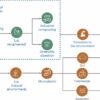Forming planets are one possible explanation for the rings and gaps observed in disks of gas and dust around young stars. But this theory has trouble explaining why it is rare to find planets associated with rings. New supercomputer simulations show that after creating a ring, a planet can move away and leave the ring behind. Not only does this bolster the planet theory for ring formation, the simulations show that a migrating planet can produce a variety of patterns matching those actually observed in disks.
Young stars are encircled by protoplanetary disks of gas and dust. One of the world’s most powerful radio telescope arrays, ALMA (Atacama Large Millimeter/submillimeter Array), has observed a variety of patterns of denser and less dense rings and gaps in these protoplanetary disks. Gravitational effects from planets forming in the disk are one theory to explain these structures, but follow-up observations looking for planets near the rings have largely been unsuccessful.
In this research a team from Ibaraki University, Kogakuin University, and Tohoku University in Japan used the world’s most powerful supercomputer dedicated to astronomy, ATERUI II at the National Astronomical Observatory of Japan, to simulate the case of a planet moving away from its initial formation site. Their results showed that in a low viscosity disk, a ring formed at the initial location of a planet doesn’t move as the planet migrates inwards. The team identified three distinct phases. In Phase I, the initial ring remains intact as the planet moves inwards. In Phase II, the initial ring begins to deform and a second ring starts forming at the new location of the planet. In Phase III, the initial ring disappears and only the latter ring remains.
These results help explain why planets are rarely observed near the outer rings, and the three phases identified in the simulations match well with the patterns observed in actual rings. Higher resolution observations from next-generation telescopes, which will be better able to search for planets close to the central star, will help determine how well these simulations match reality.
These results appeared as K.D. Kanagawa et al. “Dust rings as a footprint of planet formation in a protoplanetary disk” in The Astrophysical Journal on November 12, 2021.
Planet formation may start earlier than previously thought
More information:
K.D. Kanagawa et al, Dust rings as a footprint of planet formation in a protoplanetary disk, The Astrophysical Journal (2021). arXiv:2109.09579 [astro-ph.EP] arxiv.org/abs/2109.09579
Provided by
National Institutes of Natural Sciences
Citation:
Simulations provide clue to missing planets mystery (2021, November 12)
retrieved 12 November 2021
from https://phys.org/news/2021-11-simulations-clue-planets-mystery.html
This document is subject to copyright. Apart from any fair dealing for the purpose of private study or research, no
part may be reproduced without the written permission. The content is provided for information purposes only.



